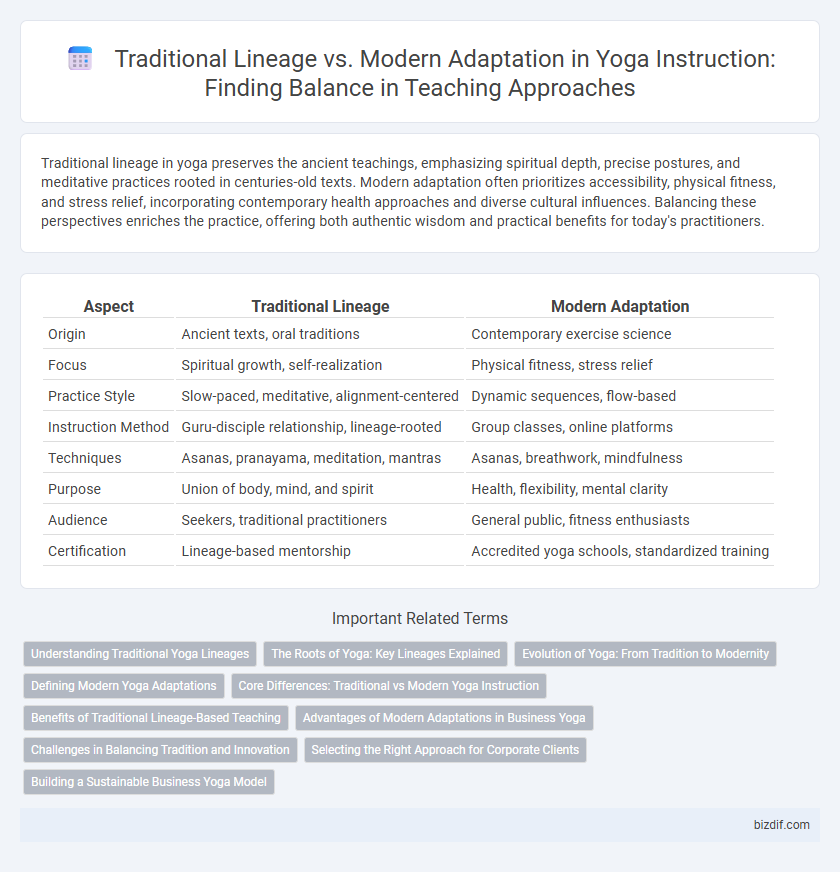Traditional lineage in yoga preserves the ancient teachings, emphasizing spiritual depth, precise postures, and meditative practices rooted in centuries-old texts. Modern adaptation often prioritizes accessibility, physical fitness, and stress relief, incorporating contemporary health approaches and diverse cultural influences. Balancing these perspectives enriches the practice, offering both authentic wisdom and practical benefits for today's practitioners.
Table of Comparison
| Aspect | Traditional Lineage | Modern Adaptation |
|---|---|---|
| Origin | Ancient texts, oral traditions | Contemporary exercise science |
| Focus | Spiritual growth, self-realization | Physical fitness, stress relief |
| Practice Style | Slow-paced, meditative, alignment-centered | Dynamic sequences, flow-based |
| Instruction Method | Guru-disciple relationship, lineage-rooted | Group classes, online platforms |
| Techniques | Asanas, pranayama, meditation, mantras | Asanas, breathwork, mindfulness |
| Purpose | Union of body, mind, and spirit | Health, flexibility, mental clarity |
| Audience | Seekers, traditional practitioners | General public, fitness enthusiasts |
| Certification | Lineage-based mentorship | Accredited yoga schools, standardized training |
Understanding Traditional Yoga Lineages
Traditional yoga lineages emphasize the preservation of ancient practices passed down through generations, rooted in Vedic scriptures and classical texts like the Yoga Sutras of Patanjali. These lineages prioritize teacher-student transmission, ensuring authenticity in techniques such as asanas, pranayama, and meditation. Understanding traditional yoga lineages helps practitioners appreciate the spiritual and philosophical foundations that distinguish classical methods from modern adaptations.
The Roots of Yoga: Key Lineages Explained
Key lineages of traditional yoga, such as Hatha, Ashtanga, and Iyengar, focus on preserving ancient practices and philosophies rooted in Indian spiritual traditions. Modern adaptations often emphasize accessibility, physical fitness, and stress relief, tailoring practices to contemporary lifestyles while occasionally diverging from classical teachings. Understanding these roots highlights the balance between maintaining authentic lineage principles and embracing innovative methods to meet today's diverse practitioner needs.
Evolution of Yoga: From Tradition to Modernity
Traditional lineage in yoga preserves ancient techniques and philosophies rooted in texts like the Yoga Sutras of Patanjali, emphasizing holistic spiritual growth and disciplined practice. Modern adaptation integrates scientific insights, accessibility, and diverse fitness goals, catering to broader audiences while often streamlining or modifying classical teachings. This evolution reflects yoga's dynamic nature, balancing heritage with contemporary relevance to promote physical health, mental wellness, and personal transformation.
Defining Modern Yoga Adaptations
Modern yoga adaptations emphasize accessibility, incorporating diverse physical fitness trends and therapeutic practices to suit contemporary lifestyles. These adaptations often streamline traditional sequences, prioritize secular mindfulness, and integrate elements from disciplines like Pilates and physiotherapy for enhanced functional health. This approach contrasts with the traditional lineage, which strictly adheres to ancient philosophies, classical asanas, and spiritual frameworks rooted in historical texts such as the Yoga Sutras and Hatha Yoga Pradipika.
Core Differences: Traditional vs Modern Yoga Instruction
Traditional yoga instruction emphasizes lineage-based practices rooted in ancient texts like the Yoga Sutras and Hatha Yoga Pradipika, focusing on spiritual growth, meditation, and strict adherence to techniques passed down through generations. Modern yoga adaptation prioritizes physical fitness, flexibility, and stress relief, often integrating contemporary exercise methods and science-backed health benefits. Core differences lie in traditional yoga's holistic spiritual approach versus modern yoga's fitness-oriented, accessible methodology driven by popular wellness trends.
Benefits of Traditional Lineage-Based Teaching
Traditional lineage-based teaching preserves authentic yoga techniques rooted in centuries-old wisdom, ensuring precise alignment and deep understanding of postures and breathing methods. This method fosters a strong teacher-student relationship, promoting personalized guidance that addresses individual needs and spiritual growth. Practitioners benefit from a structured progression that enhances physical, mental, and emotional balance through time-tested practices.
Advantages of Modern Adaptations in Business Yoga
Modern adaptations in business yoga offer increased accessibility and customization, catering to diverse corporate environments and employee needs. These approaches integrate stress management techniques with contemporary wellness trends, enhancing employee engagement and productivity. Flexible scheduling and virtual classes expand reach, making yoga more inclusive and scalable for modern workplaces.
Challenges in Balancing Tradition and Innovation
Traditional yoga lineages emphasize preserving ancient teachings and authentic practices, often resisting rapid changes to maintain spiritual depth. Modern adaptations introduce innovative techniques and contemporary fitness elements to appeal to broader audiences, creating tension between authenticity and accessibility. Balancing these requires instructors to integrate time-honored philosophies with evolving methods while respecting cultural origins and meeting current practitioners' needs.
Selecting the Right Approach for Corporate Clients
Corporate clients benefit from a tailored yoga approach that balances traditional lineage principles with modern adaptations to address workplace stress and sedentary lifestyles. Emphasizing alignment, breath control, and mindfulness from classical practices enhances mental clarity, while incorporating dynamic sequences and shorter sessions meets corporate time constraints. Selecting the right approach involves assessing employee needs, promoting wellness, and improving productivity through a customized blend of authentic and contemporary yoga techniques.
Building a Sustainable Business Yoga Model
Traditional lineage in yoga emphasizes preserving ancient teachings and authentic practices, fostering a deep, spiritual connection that builds loyal, long-term student relationships. Modern adaptation integrates contemporary marketing strategies, digital platforms, and wellness trends to attract diverse clientele and scale operations efficiently. Balancing these approaches creates a sustainable business model that honors yoga's roots while meeting evolving market demands and ensuring financial viability.
Traditional lineage vs Modern adaptation Infographic

 bizdif.com
bizdif.com